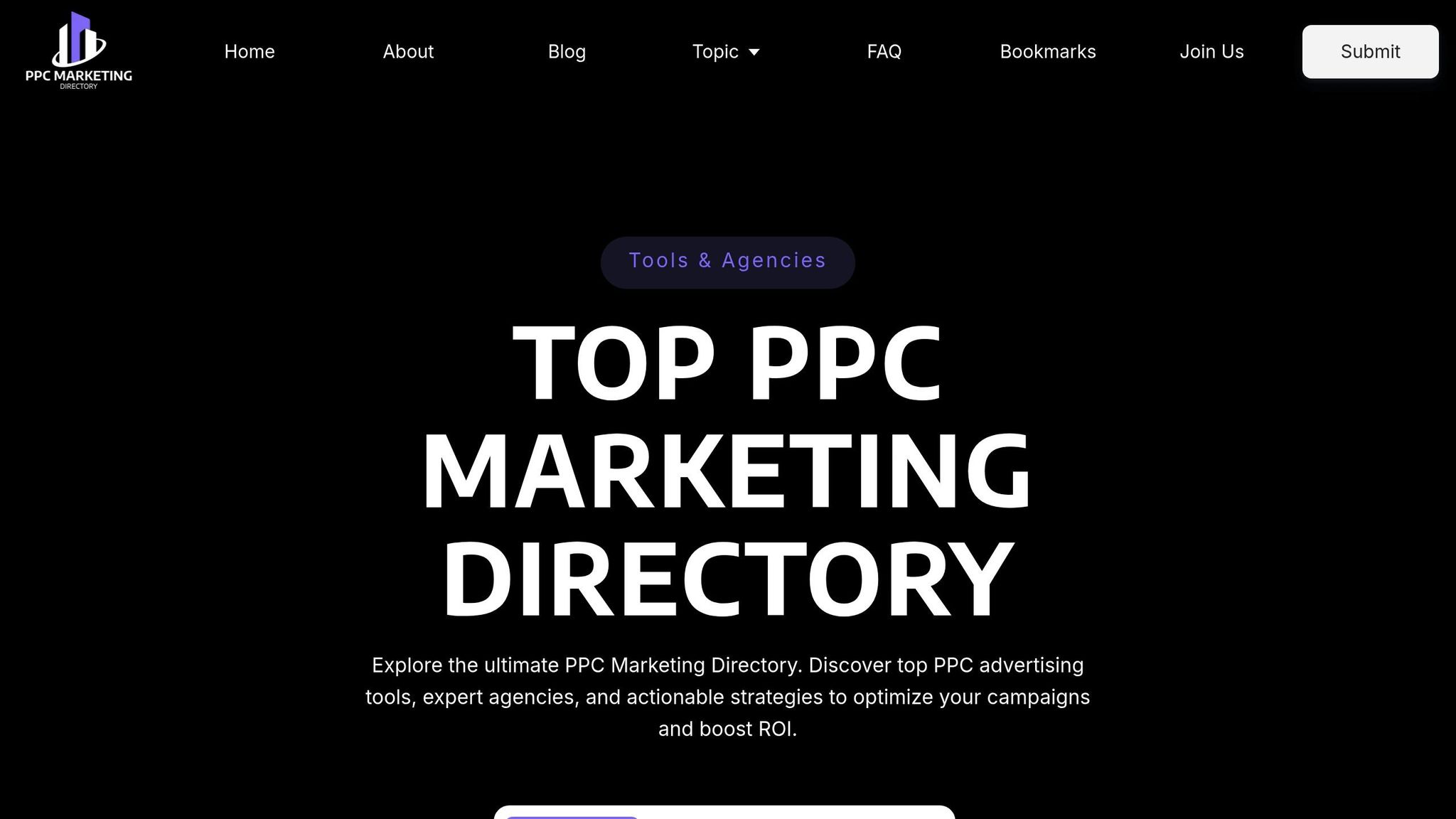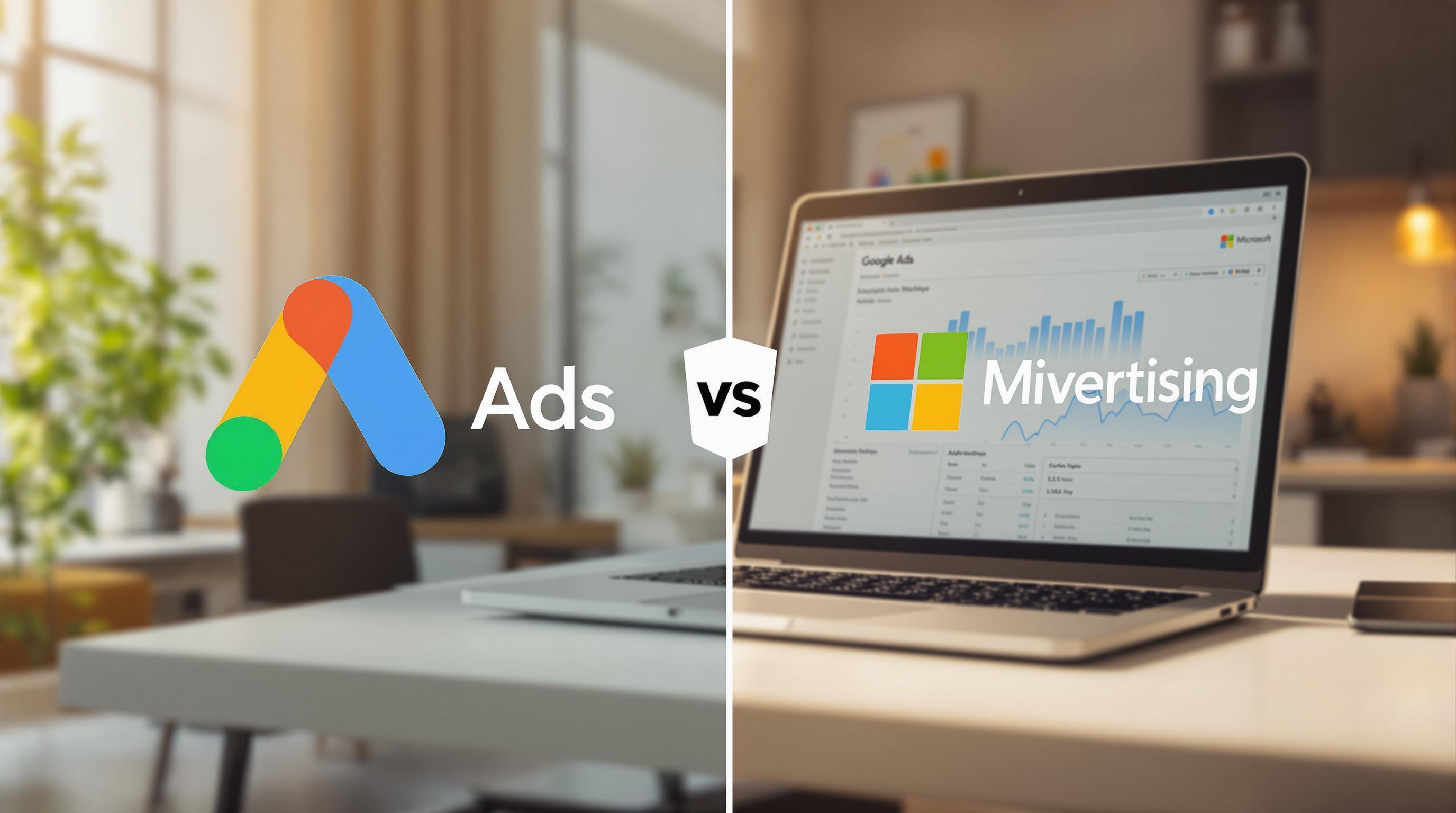Performing a Google Ads keyword audit ensures your ad campaigns are optimized for better performance and ROI. Regular audits help identify underperforming keywords, improve Quality Scores, and reduce wasted ad spend. Here's a quick breakdown:
-
Why Audit?
Find and fix underperforming keywords, lower costs, and boost conversions. -
Preparation:
Set measurable goals (e.g., reducing CPA, increasing CTR), gather tools like Google Ads, GA4, and third-party platforms (e.g., SEMrush, Wordstream), and analyze 30–90 days of performance data. -
Key Steps:
- Check keyword relevance to align with user intent.
- Review metrics like CTR (target >1%), conversion rates (aim >4.61%), and CPA.
- Adjust match types and add negative keywords to filter irrelevant traffic.
- Refine keyword lists by pausing poor performers and expanding high-potential terms.
-
Tools to Use:
Free tools: Google Ads Editor, Keyword Planner.
Paid options: SEMrush ($140/month), SpyFu ($39/month). -
Next Steps:
Document findings, prioritize changes using the ICE framework (Impact, Confidence, Ease), and schedule regular audits to maintain performance.
Optimizing your keywords saves money, improves ad placement, and keeps your campaigns competitive. Start your audit today to make your ad spend work harder.
Paid Search Audit - Part 3 - Keyword Strategy
How to Prepare for Your Keyword Audit
Getting ready for a keyword audit starts with setting clear objectives and gathering the right tools. This step isn’t just about accumulating data - it’s about working with purpose to make meaningful improvements for your business. A solid preparation phase ensures that your efforts are focused and effective.
Set Clear Audit Goals
Your goals should align directly with your business objectives and be measurable. As Herman Jooste, Managing Director at Herjoo Online Solutions, puts it:
"The goal of a Google Ads audit is to improve your campaigns and increase your ROI."
Begin by defining what success means for your specific situation. Common goals include boosting conversions, lowering your cost per acquisition (CPA), and increasing brand awareness. Depending on your campaign needs, you might also aim to improve click-through rates or reduce cost per click.
Jot down two or three specific, measurable goals. This will help you stay focused and prioritize the most pressing issues. Remember, effective goals are not just measurable but also tied to outcomes that matter for your business - steering clear of vanity metrics.
Once your goals are in place, it’s time to gather the tools and data needed to execute your strategy.
Gather Required Tools and Data
Having the right tools and data on hand makes the audit process smoother and ensures you uncover all critical insights. Your toolkit should include a mix of Google’s native platforms and third-party tools for deeper analysis.
Start with the essentials: Google Ads, GA4, and Google Ads Editor. Make sure Google Ads and GA4 are properly linked so you can track the entire customer journey, from the first click to final conversion.
For additional insights, third-party tools are invaluable. For example:
- SEMrush: Tracks website visibility, identifies ranking keywords, and compares your performance against competitors.
- Wordstream: Offers a quick audit tool that evaluates ad campaign performance and suggests ways to improve click-through and conversion rates.
- Opteo: Provides data-driven recommendations and customizable reports to enhance campaign results.
Before diving into the audit, gather key data like keyword performance metrics, search terms reports, conversion tracking info, and audience performance data. To get meaningful insights, set your date range to cover at least 30–90 days. For seasonal businesses, a longer timeframe might be more appropriate.
Also, ensure your data reflects U.S. preferences for accuracy. In Google Ads, adjust your settings under "Preferences" by selecting English (United States) for the display language and number format (currency as $ and dates in MM/DD/YYYY format). Similarly, in Google Ads Editor, go to Tools > Settings (Windows) or the Google Ads Editor menu > Preferences (Mac) to select date formats like MM/DD/YY or M/D/YY.
Don’t forget to review UTM parameters, conversion goals, and GA4 audience settings to make sure you’re capturing complete performance data. Explore specialized PPC tools in the Top PPC Marketing Directory for even more options.
Step-by-Step Keyword Audit Process
Follow this step-by-step guide to perform a thorough keyword audit. Each step builds on the last, so tackle them in order to get the best results. Start by ensuring your keywords are relevant to your audience and goals.
Check Keyword Relevance
The first step is to confirm that your keywords align with what you're offering and what your customers are actively searching for. This is especially important when setting up a Google Ads campaign. Go through your keyword list and check if each term reflects customer search behavior. Keywords should connect to the way people think and search - customer intent drives every Google search.
To assess relevance, compare each keyword against three key factors: your business offerings, campaign goals, and landing page content. If a keyword doesn’t clearly tie into all three, it’s likely working against you. Irrelevant keywords can waste ad spend by attracting the wrong clicks.
A quick way to spot relevance issues is by looking at your click-through rate (CTR). A high CTR means users find your ads helpful. On the flip side, a CTR below 1% on the Search Network often indicates your ads aren’t resonating with your audience. Use this as a signal to refine your keywords.
Think like your customers: if you were searching for your services, what terms would you use?. Additionally, ask for customer feedback to better understand their needs and search habits. These insights can uncover gaps between what you assume they’re searching for and what they’re actually typing into Google.
Review Performance Metrics
Dive into performance metrics like impressions, clicks, CTR, CPC, conversions, conversion rate, CPA, ROAS, and Quality Score. These numbers reveal how well your keywords are performing.
Compare your data to industry benchmarks: the median Google Ads conversion rate is 4.61%, the median cost per conversion is $34.61, the median CTR is 4.99%, and the median CPC is $1.79.
| Metric | What It Shows | Red Flags to Watch |
|---|---|---|
| CTR | Ad appeal and relevance | Below 1% on Search Network |
| Conversion Rate | Traffic quality and landing page success | Significantly below 4.61% median |
| CPA | Cost-effectiveness per conversion | Costs rising without revenue |
| Quality Score | Keyword and ad relevance | Below 5 |
"We monitor Google Ads performance on a daily basis, focusing on the clients' KPIs. Usually, within our pool of clients, this is conversions and/or cost per conversion. Ultimately, the key is to test different strategies and adapt based on performance, regardless of the budget size."
Compare your Google Ads conversion rates with other channels in Google Analytics. If your Ads conversions are much lower than those from organic search or other channels, it may indicate that your keyword targeting needs adjustment.
Fix Match Types and Search Intent
Once you've reviewed performance, refine your match types to better align with user intent. Match types determine when your ads appear, but they’re often used incorrectly. Understanding search intent is key to optimizing these settings.
Broad match keywords can sometimes attract irrelevant traffic. For instance, Thrive Agency highlighted in October 2024 how a campaign using the broad match keyword "tea cups" could trigger ads for unrelated searches like "tea party decorations" or "tea-making equipment". This mismatch wastes budget on users who aren’t interested in your product.
To avoid this, start with phrase match and exact match keywords, especially for new campaigns. These give you more control over when your ads are shown and help ensure your audience is more targeted.
Look for patterns in your performance data, such as keywords with high clicks but low conversions. This often signals misaligned intent. If this happens, either adjust the match type to something more restrictive or pause the keyword entirely.
Add and Update Negative Keywords
Regularly check your Search Terms Report to identify irrelevant queries that are eating up your budget. This report helps you spot patterns and add terms to your negative keyword list.
Sort your Search Terms Report by cost or clicks to quickly find irrelevant terms that are costing you the most. If you notice recurring themes in irrelevant searches, add broader negative keywords to block similar queries.
Take a dual approach: add high-performing search terms as keywords while labeling irrelevant terms as negatives. This way, you can capture more valuable traffic while filtering out the waste.
Use negative keywords at both the campaign and account levels. Campaign-level negatives are useful for specific situations, while account-level lists save time by applying across multiple campaigns.
For example, if irrelevant searches are draining your budget, adding those terms to your negative keyword list will prevent future waste. Include exact matches and variations of these terms to cover all bases.
Update and Improve Keyword Lists
With all the insights gathered, it’s time to refine your keyword lists. Start by pausing underperforming keywords and optimizing those with potential. Focus on keywords with consistently poor performance or Quality Scores below 5 - these should be your top priority for removal or adjustment.
For underperforming keywords that still show promise, try reducing bids, narrowing demographic or geographic targeting, or scheduling ads during peak times. These tweaks can lower your CPA and boost ROAS.
Leverage your Quality Score to cut costs and improve ad positioning. A higher Quality Score means better alignment between your keywords, ads, and landing pages.
Refine match types based on data from your Search Terms Report. For instance, convert broad match keywords to phrase match for better control, or expand exact match keywords to phrase match to increase volume.
Look for opportunities to expand your keyword list using tools like Google Ads Keyword Planner. As Google puts it, "The right keywords can get your ad in front of the right customers, and Google Ads Keyword Planner is here to help". Add new keywords that align with your best-performing terms, but start with restrictive match types to maintain precision.
Lastly, test different ad copy to ensure it matches the intent behind your updated keyword lists. Sometimes, the issue isn’t the keyword itself - it’s the ad not resonating with the audience’s intent. A small tweak in messaging can make a big difference in CTR.
Tools and Resources for Keyword Auditing
Once you've gathered your data, the next step is diving into tools that can analyze and refine your keywords. The right tools can turn a daunting manual audit into a smooth, data-driven process. PPC tools handle tasks like bid adjustments, keyword research, and performance tracking, while also helping you spot hidden errors in ad campaigns. Considering businesses earn an average of $8 for every $1 spent on Google Ads, having the right tools in your arsenal is crucial for maximizing returns.
When choosing keyword auditing tools, focus on features that offer actionable insights. Look for tools with site analysis capabilities, detailed reporting, accurate data, seamless integration with other SEO platforms, and solid customer support. Many modern tools even incorporate AI to detect patterns and suggest optimizations.
"AI is no longer non-essential; it's a core part of an SEO audit tool. I looked for tools that incorporated AI to help identify data patterns and suggest optimizations the human eye might overlook. As search algorithms evolve, manual analysis just isn't enough to keep up."
– Bryce Emley
Free Tools vs. Paid Tools
For those just starting out, free options like Google Ads Editor and Google Keyword Planner provide a solid foundation. If you're ready to invest in advanced features, paid tools offer more automation and sophisticated capabilities. For example:
- Semrush: Starting at $140/month, this all-in-one platform handles keyword research, ad copy analysis, and competitor insights.
- Optmyzr: Starting at $299/month, it's tailored for PPC management, ideal for agencies managing larger budgets.
If competitor research is your focus, tools like SpyFu and iSpionage provide deep insights:
- SpyFu: Starting at $39/month, it reveals every keyword your competitors have paid for and their historical ads.
- iSpionage: Starting at $59/month, it specializes in PPC campaigns and landing page analysis, helping you uncover competitors' strategies.
Here’s a quick comparison of tools to guide your selection:
| Tool Category | Free Options | Paid Options (Starting Price) |
|---|---|---|
| Campaign Management | Google Ads Editor, Microsoft Advertising Editor | Optmyzr ($299/month), Adalysis ($149/month) |
| Keyword Research | Google Keyword Planner | Semrush ($140/month), SpyFu ($39/month) |
| Competitor Analysis | Meta Ad Library | iSpionage ($59/month), SpyFu ($39/month) |
| Social Media Ads | – | AdEspresso ($49/month) |
With these tools, you can take your keyword audit insights and turn them into actionable improvements for your campaigns.
Top PPC Marketing Directory Overview

The Top PPC Marketing Directory is a go-to resource for finding the best PPC tools, expert agencies, and services tailored to U.S. businesses. It’s designed to simplify the search for resources like campaign management, bid strategies, keyword research, ad copy optimization, A/B testing, retargeting, and performance tracking.
What makes this directory stand out is its focus on helping users compare agencies based on expertise, industry experience, budget, location, and client reviews. This is especially useful for keyword audits, as you can connect with agencies that excel in creating high-performing ad campaigns across platforms like Google, Bing, Amazon, and YouTube.
The directory highlights agencies offering services critical for keyword optimization, such as account setup, ad copy refinement, audience targeting, and detailed analytics. When evaluating agencies, it’s important to consider their data expertise, keyword research skills, and ability to optimize for local and mobile searches.
Pricing transparency is another key feature of the directory. PPC agencies typically charge based on the scale and complexity of your campaigns. Some use a percentage-based model (10–20% of total ad spend), while others charge flat fees, independent of campaign hours.
To ensure you’re working with the best, the directory encourages users to vet agencies with high ratings (4.5+ stars) on platforms like Google, Clutch, or Trustpilot. Detailed client success stories can also provide insight into how well an agency can improve lead generation or sales. This approach ensures you're partnering with professionals who can turn audit insights into measurable results, helping you achieve the industry average of $2 in revenue for every $1 spent on Google Ads.
Whether you’re after specialized keyword tools or expert agencies to manage your entire audit process, the Top PPC Marketing Directory connects you with vetted, U.S.-focused resources. These tools and agencies understand the nuances of the American market, helping you transform your audit findings into better-performing campaigns.
sbb-itb-89b8f36
How to Use Results and Make Changes
Your keyword audit has pinpointed performance issues in your campaigns. Now it’s time to turn those insights into actionable steps that improve your return on investment. The key is to make changes in a structured way rather than rushing into random adjustments that might throw your campaigns off balance.
Review Key Findings
Start by organizing your findings using the ICE framework - Impact, Confidence, Ease. This helps you prioritize actions based on their potential effect, your confidence in their success, and how easy they are to implement. Create a priority matrix to separate quick fixes from more strategic, long-term changes.
Quick wins could include steps like pausing irrelevant keywords or adding negative keywords to block unhelpful search queries. For bigger strategic adjustments, you might need to restructure ad groups or rethink how your budget is allocated. Focus especially on high-spending keywords with poor conversion rates and look for trends among underperforming keyword groups.
Amy McClain-Ponder, a customer of Optmyzr, shared her team's method for prioritizing tasks:
"For our monthly audits, we use a checklist that our team has created to go through the audit. We use Optmyzr's PPC Audits once a month and work through changes on that list from the most impactful first."
When documenting your findings, be specific. Include numbers and percentages to make your case. For example, if 15 keywords are eating up 40% of your budget but only contributing 8% of conversions, that’s a clear high-priority issue worth addressing.
Once you’ve set your priorities, move on to implementing the changes.
Make Changes and Track Results
Start with changes that offer the highest impact with the least risk. This could include pausing underperforming keywords or adding negative ones. As you implement these updates, set up tracking dashboards to monitor key metrics in real time. Metrics like cost per click (CPC), conversion rate, cost per acquisition (CPA), and return on ad spend (ROAS) are essential for evaluating your adjustments.
To stay organized, develop a detailed plan that includes timelines, task owners, and deadlines. This roadmap ensures changes are manageable and makes it easier to pinpoint which updates are driving results.
Set Up Regular Audit Schedule
Once your initial changes are in place, keep the momentum going with regular audits. A monthly review schedule is ideal for catching issues early and staying on top of campaign performance. Use a standardized checklist to evaluate keyword performance, search terms, negative keywords, match types, and budget allocation. Regular reviews not only help you spot new opportunities but also build on past insights, allowing you to fine-tune strategies and identify what delivers consistent results.
Conclusion
A Google Ads keyword audit isn't a one-and-done task - it's an ongoing process that keeps your campaigns running smoothly and effectively. As Sam Yadegar, CEO of HawkSEM, explains:
"You should consider doing a Google ads audit when there's fluctuation in performance, both good and bad... When things are bad, an audit can help uncover what's wrong and help steer you in the right direction, but equally, when things are good, doing an audit helps capture those winning learnings that can help a campaign scale."
Think of it like routine car maintenance - regular audits help you avoid costly missteps while keeping up with shifting search trends, evolving competitor strategies, and changing user behaviors. A well-structured audit identifies areas where your budget might be wasted, uncovers new growth opportunities, and ensures your campaigns stay competitive. Plus, improving your Quality Scores can reduce your cost-per-click (CPC) and secure better ad placements.
The right tools and resources can make this process far more efficient. Platforms like Top PPC Marketing Directory provide access to specialized keyword research tools, campaign management systems, and analytics that automate repetitive tasks and reveal valuable insights.
FAQs
What are the biggest mistakes to avoid when auditing Google Ads keywords?
Avoiding Common Mistakes During a Google Ads Keyword Audit
When it comes to improving your Google Ads campaigns, steering clear of common keyword audit mistakes can make a huge difference. Here are some pitfalls that can derail your efforts - and how to avoid them:
- Neglecting negative keywords: If you’re not excluding irrelevant search terms, you could be throwing money away on unqualified traffic. Negative keywords help ensure your ads only appear for searches that matter.
- Over-relying on broad match keywords: Broad match keywords can cast too wide a net, leading to your ads showing up for unrelated searches. This not only eats into your budget but also lowers your ROI.
- Skipping regular keyword research: Trends change, and so do search behaviors. If you’re not regularly revisiting your keyword strategy, you’re likely missing opportunities to target new, high-performing terms.
- Misusing match types: Choosing the wrong match types - like relying too much on exact matches or ignoring phrase matches - can either limit your reach or waste money on irrelevant clicks.
- Setting unrealistic budget caps: Budgets that are too tight can choke your campaign’s potential, while overly generous caps might lead to overspending without delivering results.
By tackling these issues head-on, you’ll be in a better position to fine-tune your keyword strategy and get the most out of your Google Ads campaigns.
What are negative keywords, and how can they improve my Google Ads campaign?
Negative keywords are a powerful way to ensure your ads don’t show up in searches that don’t align with your goals. By excluding specific terms or phrases, you can direct your budget toward traffic that’s more relevant, which helps improve both your click-through rates (CTR) and conversion rates.
To make the most of negative keywords, you’ll want to add them at either the campaign or ad group level, depending on your strategy. Be sure to select the right match type - broad, phrase, or exact - so you have control over which searches are filtered out. It’s also important to regularly check your search term reports. This will help you spot irrelevant queries and update your negative keyword list as needed. By staying on top of this process, you can fine-tune your targeting, save money, and get better results from your campaigns.
What are the advantages of using third-party tools like SEMrush or SpyFu for a keyword audit instead of relying solely on Google Ads' built-in tools?
Third-party platforms such as SEMrush and SpyFu offer a deeper dive into your keyword performance and campaign strategies. They expand on the capabilities of Google Ads by providing features like competitor analysis, extensive keyword tracking, and detailed insights for both SEO and PPC.
These tools can help you uncover missed opportunities, refine your ad targeting, and stay ahead of the competition. While Google Ads' built-in tools are useful, third-party solutions give you a broader and more detailed view, helping you fine-tune your campaigns for better results.


